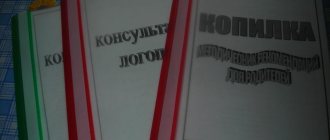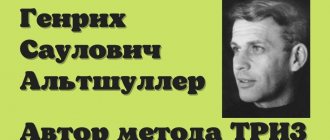MAGAZINE Preschooler.RF
Municipal budgetary preschool educational institution “Kindergarten No. 3 “Solnyshko”, Adamovka village, Orenburg regionWinner of the all-Russian competition “The most popular article of the month” DECEMBER 2017 Prepared by: teacher - speech therapist of the highest category N.V. Makarova Dear participants! Today I will conduct a small speech therapy master class with you. I will show you a set of exercises for individual work in production and automation of sounds. The basis of the proposed system is forms and methods of work using proprietary didactic games and manuals. We all know well that it is easier to prevent shortcomings than to eradicate them.
Quote: Without speech there is neither consciousness nor self-awareness (Lev Semyonovich Vygotsky)
Motto: Listen - and you will know, look - and you will understand, do - and you will learn, make us better!
Equipment: 1. Individual mirrors 2. Cotton pads. 3. Cotton swabs. 4. Finger cap. 5. Cocktail straws.
6. Cups with a lid, 7. Staging speech therapy probes. 8. Oral cavity “RATATUSKA”. 9. Tongue theater. 10. Balloons. 11. Butterfly made of papyrus paper. 12. Pinwheel. 13. Plastic lips for the development of an air stream. 14. Massage ball with spikes “Hedgehog”. 15. "Su-jok". 16. Ball with rubber bands. 17. Clothespins. 18. “Baby Elephant - Elephone” - for the development of phonemic hearing.
Program:
1. Generalization of teaching experience on the topic. 2. Exercises for setting and automating sounds. 3. Reflection on experience: B) what was useful (interesting). C) what do you remember about the master class?
Goal: Providing generalization, systematization and dissemination of personal pedagogical experience to a wide audience of preschool teachers. Objectives: 1. Creating conditions for the professional development of a teacher, during which experience is gained in the formation of speech exercises for the normal speech development of children of senior preschool age. 2. Formation of an individual style of creative pedagogical activity in the process of innovative work. In recent years, there has been an increase in the number of preschoolers with disorders of general and speech development. A chain of unfavorable factors leads to the fact that already in the middle group of kindergarten we find up to 60% of pupils with speech development disorders. The most important indicator of children’s preparedness for school is their level of speech development. After all, first the child masters auditory speech. Correcting deficiencies in sound pronunciation at an older age is much more difficult than preventing them in the early stages of a child’s development. Work on the sound culture of speech includes the following sections: • development of movements of the articulatory apparatus (articulatory gymnastics); • consistent work on correcting problematic sounds. • prevention of speech disorders. Working as a speech therapist in a public preschool, I would like to note the difficulties that I encounter every day. First of all, this is the fact that a speech therapist at a speech center is integrated into the general educational process, and does not go along with it, as is customary in speech kindergartens. The work of a speech therapist in a kindergarten, which does not have specialized groups in its structure, is structured taking into account the internal schedule of the preschool educational institution. Classes are short-term (15-20 minutes), short-term (2-3 times a week) and are designed for a 6-month or 12-month training period. The speech therapist is forced to become involved in the learning process on the day the child attends his classes. Children with speech disorders themselves receive correctional assistance in portions, and not daily, like children in a speech therapy kindergarten. Thus, in my work, the need arose for close interaction and mutual assistance between the speech therapist and educators, the speech therapist and parents. Both of them are deprived of specialized correctional hours for working with children who are speech pathologists. For this purpose, I have developed a certain set of master classes for teachers and parents, which is called “Home Speech Therapy Lessons.” Today we will get acquainted with one of the main topics of the master class complex, this is “Secrets in the work of a speech therapist teacher in producing and automating sounds.” How to explain to parents in accessible language what speech is? (Building a house) And now let’s move on to the sections in which work on producing sounds is carried out:
Work on the development of the articulatory apparatus
In order for sound pronunciation to be clear, you need strong, elastic and mobile speech organs - tongue, lips, soft palate. Since all speech organs are made up of muscles, they can therefore be trained. Gymnastics aimed at developing the speech organs is called articulation. Such gymnastics helps strengthen speech muscles and prepares the basis for clear sound pronunciation. You can come up with fairy tales that will help children cope with some speech difficulties. Playing them with children, we see that the production of sounds goes faster, and children show keen interest even when performing very difficult articulation exercises.
Working on gross and fine motor skills
Children with speech impairments often have deficits in gross motor skills. Body movements and speech motor skills have common mechanisms, so the development of fine motor skills of the hands directly affects the development of speech. That is why the development of fine motor skills should take a strong place in activities with the child. Children with speech delay have poor coordination of fine motor skills of their fingers. And as a result, dysgraphia (writing impairment) may develop. The higher the child’s motor activity, the better his speech develops.
Development of correct speech breathing
The key to clear pronunciation of sounds and clear diction is well-established speech breathing. Children are given daily exercises to develop speech breathing.
Development of phonemic hearing
The ability to focus on sound - we develop auditory attention. A small child does not know how to compare sounds, but he can be taught this. The purpose of exercises for the development of phonemic awareness is to teach the child to listen and hear.
The joint work carried out with educators and parents shows that close cooperation in conditions of limited exposure and the use of speech therapy techniques helps in quickly solving problems of correctional intervention.
Thus, the effectiveness of the work of the teacher-speech therapist increases, the percentage of children with speech defects before entering school decreases, and the percentage of children graduating with literate speech and correct pronunciation increases.
So, the main organ of the articulatory apparatus is the TONGUE!
Practical part
And now, I invite you to attend such speech therapy classes and participate in them with me, and my assistant will help me conduct them, meet Oral Cavity, RaTaTuShkA.
I always start the practical part of my master class with these words:
“Rejoice at even small achievements, strive for perfection, as it has no limit!”
Stage 1 in producing sounds –
ARTICULATIVE GYMNASTICS
We will begin with you by performing articulatory gymnastics. Why do we do it? In order for you to feel what facial muscles are and that you really have them. In total, as cosmetologists say, we have more than 200 facial muscles. Girls, do not be afraid to grimace, because a frozen grimace creates wrinkles, and articulatory gymnastics, which constantly changes the face, only pumps up the muscles, and almost all speech therapists maintain a beautiful oval face for a long time. In real life, you and I do several actions during a conversation: we talk and look, talk and listen. And sometimes to introduce sound into speech you need to do not one, not two, but several actions. Thus, you and I will talk and perform the action with the help of our assistants: I have the oral cavity, the participants have the Tongue Theater.
1. We extend and stretch our lips forward as much as possible, while saying: UNDERSTANDING - and so on 8 times. 2. A mouse crawls along the wall: PEEP-PEEP ———EEEEEE. We stretch our lips forward as much as possible and pronounce UUUU, and while stretching our lips as much as possible we pronounce EEEE. 3. Let’s do the “Football” exercise. We take turns pressing our tongue on one side of the cheek, then on the other, literally pushing the cheek apart. We accompany the action with a voice similar to the sound U. Do not forget that when performing this exercise we have a sharp tongue, a hard tip. And so 8 times. 4. They say that there is a gene for curling the tongue. Let us roll up the tongue into a tube and blow on the tip of the tongue. If you can’t make a straw, we make a “cup” like this. 5. Exercise “Clock”. Touch your tongue to the left corner of your mouth and fix this position. The same with the right corner of the mouth. 6. Exercise “Mushroom”. The mouth is open. Lips in a smile. Press the wide tongue with its entire plane to the palate (the tongue is suctioned) and hold it in this position for a count of 1 to 8. 7. Exercise “Delicious jam”. Using the wide front edge of your tongue, lick your upper lip and then your lower lip. 8. Exercise “Horse”. The mouth is open. Lips in a smile. Press the wide spade-shaped tongue to the palate and tear it off with a click. Make sure that the lower jaw does not move while performing this exercise. 9. Exercise “Drum”. The mouth is open. Lips in a smile. Using the wide tip of your tongue, tap the palate behind your upper teeth, pronouncing the sound D-D-D repeatedly and clearly. At first the sound is pronounced slowly, then the tempo accelerates. Make sure that the D sound is pronounced very firmly.
Now tell me, how do you feel? Do you feel a rush of blood? Tingling? That's good, we got all our 200 facial muscles working!
Don’t worry if you don’t quite succeed, after a while everyone succeeds!!! Group classes help children adapt, while individual classes help them set the volume. There are cases when it is impossible for a child to make hissing sounds and the sound R, this is due to a shortened hyoid frenulum, then I refer such children to an orthodontist.
Stage 2 –
DEVELOPMENT OF SPEECH BREATHING
Speech breathing exercises
1. Inhale air through the nose (do not raise your shoulders, exhale should be long and smooth, you must make sure that your cheeks do not puff out (you can hold them with your hands first) 2. Blow the butterfly off the tip of your nose. 3. Storm in a glass. We take two plastic transparent cups. In one we pour a lot of water, almost to the brim, and in the other we pour a little. We invite the child to play “a storm in a glass” using cocktail tubes. To do this, blow into a glass with a lot of water through The tube is weak, but you can blow strongly into a glass where there is little water. The child’s task is to play so as not to spill the water. 4. Inflate the balloon without inflating the cheeks. 5. Pinwheel, lips.
Stage 3 - DEVELOPMENT OF FINE MOTOR SKILLS
1. Massage ball. 2. Ball with rubber bands. 3. Clothespins. 4. Sujok therapy.
Stage 5 -
SOUND PRODUCTION [P]
We have done articulation gymnastics, worked on fine motor skills, and now it’s time to move on to sound production. In this case we will use the sound [P]. To correctly pronounce the sound P, it is necessary to make the tip of our tongue tremble. This is where we need to once again recall the “Drummer” exercise. (I show 1 person using a speech therapy probe, the rest I try to do the same, only using my finger and fingertip myself).
Stage 4 – DEVELOPMENT OF PHONEMATIC HEARING
If you hear it, clap
An adult pronounces a number of sounds (syllables, words); and the child with his eyes closed, hearing the given sound, claps his hands. (The child does not see your articulation).
Little teacher "Baby Elephant - Elephon"
Tell your child that his favorite toy wants to learn how to speak correctly. Ask your child to “explain” to the toy the name of this or that object. At the same time, make sure that the baby pronounces the words correctly and clearly.
*** An adult shows the child a picture and names the object, replacing the first letter (forota, korota, morota, gate, porota, horota). The child’s task is to clap his hands when he hears the correct pronunciation.
Game "Telegraph"
To play you need cut strips of paper and a pen. You send a telegram: “The baby elephant is sick.” The young telegraph operator lays out as many strips as there are words in a sentence. And then on each strip he draws as many circles as there are syllables in the word. The “baby elephant is sick” telegram will look like this: two paper strips with three circles on each. And I would like to end my master class with a beautiful poem that characterizes me as a teacher - speech therapist.
We practice the sound P in isolation and in syllables. “Rib – fist – palm – clap”
Now we will make the following movement: rib - fist - palm - clap (I show). And now you will understand the stages of growth in introducing sound into speech. We do all the movements together. 1. rib – fist – palm – clap; 2. r – r – r – r; ra - ra - ra - ra; ro - ro - ro - ro; ru - ru - ru - ru; ry - ry - ry - ry.
3. ra - ro - ru - ry
Great, well done! Difficult? Difficult.
And I would like to end my master class with a poem that characterizes me as a teacher - speech therapist: Patience and creativity, Perseverance and victory - These are the main stages in the work of a speech therapist. All Nadi, Vani, Vitya Must speak, And it depends on you - To be it or not to be. My heart aches for everyone. Everyone wants to help. More than once the question: “What to do?” Haunted me all night. Sometimes you walk with bags, And your tongue “fungus”, Or “horse” clicks, Or your lips “proboscis”. Suddenly the engine starts to crackle several times in a row and you catch the wary gaze of those walking by. So day after day - Now down, now up The tongue flies, Not every one of you could work so persistently. And... sounds appeared And perhaps syllables followed, And then the words already went along the right path. At the very first meeting, We often hear: “Datte,” And at parting, a clear: “Health and happiness to you!” And without false modesty I am not ashamed to admit that I am really proud of my profession! This concludes my master class, thank you very much everyone for your help and attention!
| Next > |




